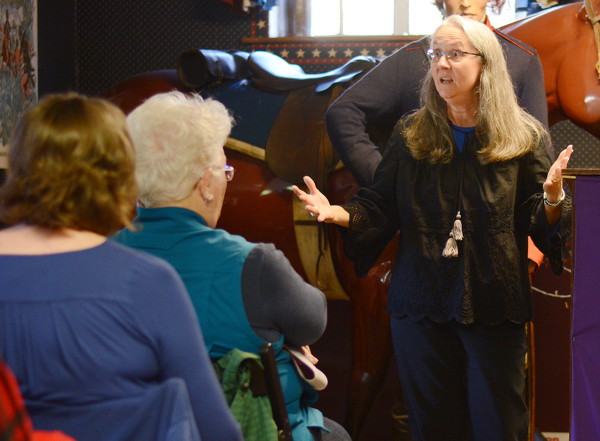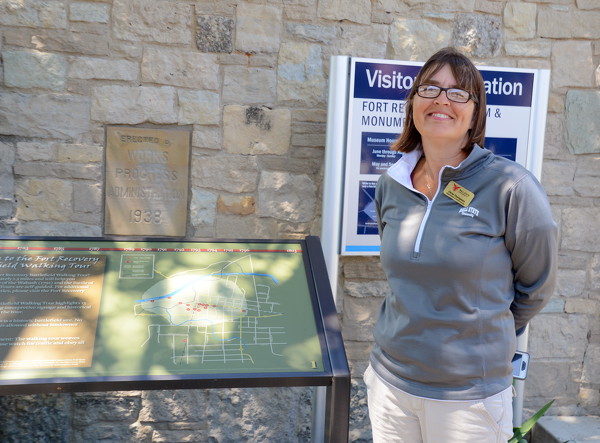Monday, May 6th, 2019
Miami Tribe has strong ties to region
Tribal officer speaks at Fort museum; new exhibits unveiled
By Leslie Gartrell

Photo by Leslie Gartrell/The Daily Standard
Diane Hunter, tribal historic preservation officer for the Miami Tribe of Oklahoma and a citizen of the tribe, speaks to a group during her presentation on the tribe's history on Sunday afternoon at the Fort Recovery Museum.
FORT RECOVERY - History enthusiasts gathered to view the dedication of 15 new wayside exhibits and hear a presentation by Diane Hunter, a citizen of the Miami Tribe of Oklahoma and Tribal Historic Preservation Officer at the Fort Recovery Museum on Sunday afternoon.
Hunter is the descendent of the Miami family of Seekaahkweeta and Palaanswa (Francois Godfroy) through their son Waapanakiikaapwa (Gabriel Godfroy). As the Tribal Historic Preservation officer, Hunter works to preserve and protect historic sites and resources, provide education about the presence and history of the Miami Tribe and serve nearly 700 tribal citizens in Indiana and surrounding areas.
She began working for the Miami Tribe in 2015 when the Tribe opened a Cultural Resources Extension Office in Fort Wayne, Indiana.
"At first, the Miamis come out of the water," Hunter said of the tribe's arrival in the region. It's the first line of their oldest story detailing how the Miami Tribe came to be. "It's the story of us becoming a people."
The story goes that the Miami Tribe came from the St. Joseph River, "the coming out place." The Miami people have lived in what is modern day Indiana, Ohio, Illinois and surrounding areas since time immemorial, Hunter said.
Groups of tribe members eventually moved to different areas, including Fort Wayne. This was at one time their largest village and later a village they shared with the Delaware and Shawnee tribes. Hunter said that about 2,000-3,000 tribe members lived in the Fort Wayne area at one point time.
Men and women had distinct roles in tribal life at the time, said Hunter. Men mostly worked outside the village - hunting, fishing, engaging in battle, making peace and trading. Men had a civil chief, whose role was not to rule or govern, but to carry out the will of the people, Hunter said. The tribe also had a war chief, a person who was chosen each time they went to battle.
Women, meanwhile, built homes, farmed, made clothing and made whatever else was needed. Since the women built the homes they also owned it, Hunter said.
"Gentlemen, I'm sorry to tell you, but if you came home and found your moccasins and weapons outside the door, you better find a new place to live," she said jokingly.
While men and women had distinct roles they were interdependent, Hunter said. No role was more valuable or superior to the other; it was what they needed to do to live.
Tribal life was changed when they were introduced to Europeans, first through disease and then through trade. The Iroquois discovered the Europeans loved beaver fur, so they hunted all the beaver they could. When they killed all the beavers in their area, they moved west toward the Miami Tribe to get more. The Iroquois had Dutch guns, something the Miami had never had, so they moved west into Illinois and north into Michigan, Hunter said. In Michigan, the Miami encountered the French for the first time.
By the 1700s, the Miami Tribe had returned to their homeland in Indiana. They continued to interact with the French and eventually the British, Hunter said. However, in the 1783 Treaty of Paris, Britain transferred their claim to the Americans for what was then considered the Northwest Territory. However, Hunter said the tribe interpreted the claim as trading rights. The Miami Tribe had allowed the British to have trading posts and to trade with the Miami on their land. The British didn't have anything other than trading rights, Hunter said, and they had no right to give away land that wasn't theirs.
Americans started moving west because they valued private property and started to infringe onto tribal land. It led to skirmishes, battles and eventually war. St. Clair's defeat in 1791 was a decisive loss, said Hunter, but the tide turned in Battle of Fallen Timbers when they lost. In 1795 they signed the Treaty of Greenville to end the fighting. The treaty was supposed to be a dividing line, said Hunter.
"The Americans get this land, we get this land. We each have our land, and we'll be good neighbors. But it didn't work that way," Hunter said. "They wanted more land."
The Miami continued to lose land treaty by treaty. The Treaty of 1840 saw the exchange of the Great Miami Reserve, around 500,000 acres, for what was supposed to be a similar sized tract of land in Kansas, and the Miami Tribe agreed to be removed from Indiana, Hunter said. However, the tribe largely did not expect to be removed. The leaders of the tribe understood the concept of private land ownership, said Hunter, and they, along with a large number of Miami people, had land they privately owned.
"It was enough land that all living Miami people could live on that land and not be removed," said Hunter.
The Miami Tribe was given five years leave the area. By 1846, the Miami Tribe was rounded up from their villages by gunpoint and forcibly removed, Hunter said. She explained that there are stories of tribal members who grabbed handfuls of dirt from their ancestors' graves because they knew it was the last time they would be on that land.
The Miami people eventually made it to Kansas, which had buffalo to hunt and excellent land for farming. However, the American government again attempted to force them from their land. They were given the choice to stay in Kansas and become U.S. citizens and no longer by Miami; they could go to Kansas and join the Peoria Tribe, made up of several different tribes; or they could to go Oklahoma and remain the Miami Tribe. The tribe decided to go to Oklahoma. The Indian Removal Act of 1830 was the culmination of all the previous treaties to take their land, said Hunter.
The removal process led to a broken tribe, with tribe members living in Oklahoma, Kansas and Indiana. It also led to a loss of culture.
"We were losing parts of our culture, or it went to sleep," said Hunter.
However, a cultural revitalization movement has began to bring back the parts of their culture that were asleep, according to Hunter. The Miami Tribe is headquartered in Oklahoma, and through practices such as storytelling and language revitalization they're regaining pieces of their culture. Summer camps for children teach stomp dancing, ribbon weaving and archery. And the Cultural Resources Extension Office in Fort Wayne has brought Miami people in the area together.
"We're committed to protecting and revitalizing what (our ancestors) have passed onto us," said Hunter. "But we're not a people of the past. We are a living people with a past."

Photo by Leslie Gartrell/The Daily Standard
Archaeologist Christine Thompson stands next to one of the 15 wayside exhibits she helped create. The wayside exhibits, which were dedicated Sunday, are a tour of St. Clair's Defeat, or the Battle of the Wabash, in 1791. St. Clair's Defeat is considered the most decisive defeat in the history of the American military and the largest victory ever won by Native Americans.


